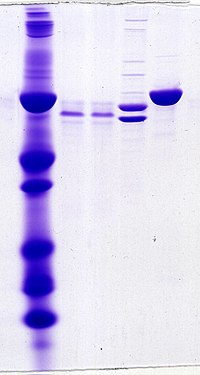
Photo from wikipedia
Abstract In this work, organosilane-derived sol-gel films containing different amounts of cerium ions applied on AA 1050 were investigated. The sol-gel coatings were prepared from 3-glycidoxypropyltrimethoxysilane (GPTMS) and methyltriethoxysilane (MTES)… Click to show full abstract
Abstract In this work, organosilane-derived sol-gel films containing different amounts of cerium ions applied on AA 1050 were investigated. The sol-gel coatings were prepared from 3-glycidoxypropyltrimethoxysilane (GPTMS) and methyltriethoxysilane (MTES) mixtures with the addition of cerium nitrate in order to achieve different concentrations of Ce ions (from 10−5 M to 10−2 M). The effect of the cerium load on the structure of the cured sol-gel films was investigated by means of solid state NMR and FT-IR spectroscopy. The corrosion protection properties of the different sol-gel layers were investigated mainly by means potentiodynamic curves and electrochemical impedance spectroscopy (EIS). FT-IR and solid state NMR suggested a significant influence of the Ce cations on the network structure: not only the degree of condensation decreases with Ce addition but also the structural modification of the silsesquioxane network is observed with preferential formation of ladder-like species for low Ce3+ content and cages predominance for Ce/Si molar ratio greater than 0.039, i.e. [Ce3+] = 1·10−4 M. Electrochemical tests revealed that the effect of Ce ions on the structure of the coatings does not lead to remarkable changes in the barrier properties. Moreover, it was found that the Ce ions seems to be present in the cured films and are able to migrate towards the metal/coating interface thus providing a stabilization of the metal interface.
Journal Title: Applied Surface Science
Year Published: 2017
Link to full text (if available)
Share on Social Media: Sign Up to like & get
recommendations!